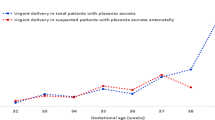Abstract
Purpose
The incidence of placenta accreta spectrum (PAS; pathologic diagnosis of placenta accreta, increta or percreta) continues to rise in the USA. The purpose of this study is to compare the hemorrhagic morbidity associated with PAS with and without a placenta previa.
Methods
This was a retrospective cohort study of 105 deliveries from 1997 to 2017 with histologically confirmed PAS comparing outcomes in women with and without a coexisting placenta previa. We used the Wilcoxon rank sum test to compare continuous data and Chi-square or Fisher’s exact test for categorical data. We also performed log-binomial regression to calculate risk ratios adjusted for depth of invasion (aRR) and 95% confidence intervals (CI).
Results
We identified 105 pregnancies with PAS. Antenatal diagnosis of PAS was higher in women with coexisting placenta previa (72.3%) than those without (6.9%, p < 0.001). Women with coexisting placenta previa had greater median estimated blood loss and more units of packed red blood cells transfused (both p ≤ 0.03). Women with placenta previa were more likely to undergo a hysterectomy (RR 2.7; 95% CI 1.8–3.8) and be admitted to the intensive care unit (aRR 3.3; 95% CI 1.1–9.6).
Conclusions
Among women with PAS, those with a coexisting placenta previa experienced greater hemorrhagic morbidity compared to those without. In addition, PAS without placenta previa typically was not diagnosed prior to delivery. This study further supports the recommendation for multi-disciplinary planning and assurance of resources for pregnancies complicated by PAS. In addition, our results highlight the need for mobilization of resources for those pregnancies where PAS is not diagnosed until delivery.
Similar content being viewed by others
References
Sheiner E, Sarid L, Levy A, Seidman DS, Hallak M (2005) Obstetric risk factors and outcome of pregnancies complicated with early postpartum hemorrhage: a population-based study. J Maternal Fetal Neonatal Med 18(3):149–154. https://doi.org/10.1080/14767050500170088
O’Brien JM, Barton JR, Donaldson ES (1996) The management of placenta percreta: conservative and operative strategies. Am J Obstet Gynecol 175(6):1632–1638
Creanga AA, Bateman BT, Butwick AJ, Raleigh L, Maeda A, Kuklina E, Callaghan WM (2015) Morbidity associated with cesarean delivery in the United States: is placenta accreta an increasingly important contributor? Am J Obstet Gynecol 213(3):384.e1–384.e11. https://doi.org/10.1016/j.ajog.2015.05.002
Wu S, Kocherginsky M, Hibbard JU (2005) Abnormal placentation: twenty-year analysis. Am J Obstet Gynecol 192(5):1458–1461. https://doi.org/10.1016/j.ajog.2004.12.074
Silver RM, Landon MB, Rouse DJ, Leveno KJ, Spong CY, Thom EA et al (2006) Maternal morbidity associated with repeat cesarean deliveries. Obstet Gynecol 107(6):1226–1232. https://doi.org/10.1097/01.AOG.0000219750.79480.84
Grobman WA, Gersnoviez R, Landon MB, Spong CY, Leveno KJ, Rouse DJ et al (2007) Pregnancy outcomes for women with placenta previa in relation to the number of prior cesarean deliveries. Obstet Gynecol 110(6):1249–1255. https://doi.org/10.1097/01.AOG.0000292082.80566.cd
Linn RL, Miller ES, Lim G, Ernst LM (2015) Adherent basal plate myometrial fibers in the delivered placenta as a risk factor for development of subsequent placenta accreta. Placenta 36(12):1419–1424. https://doi.org/10.1016/j.placenta.2015.10.004
Belfort MA (2010) Placenta accreta. Am J Obstet Gynecol 203(5):430–439. https://doi.org/10.1016/j.ajog.2010.09.013
Wright JD, Pri-Paz S, Herzog TJ, Shah M, Bonanno C, Lewin SN et al (2011) Predictors of massive blood loss in women with placenta accreta. Am J Obstet Gynecol 205(1):38.e1–38.e6. https://doi.org/10.1016/j.ajog.2011.01.040
Gibbins KJ, Einerson BD, Varner MW, Silver RM (2018) Placenta previa and maternal hemorrhagic morbidity. J Matern Fetal Neonatal Med 31(4):494–499
Warshak CR, Ramos GA, Eskander R, Benirschke K, Saenz CC, Kelly TF et al (2010) Effect of predelivery diagnosis in 99 consecutive cases of placenta accreta. Obstet Gynecol 115(1):65–69. https://doi.org/10.1097/AOG.0b013e3181c4f12a
Eller AG, Porter TF, Soisson P, Silver RM (2009) Optimal management strategies for placenta accreta. BJOG 116(5):648–654. https://doi.org/10.1111/j.1471-0528.2008.02037.x
Shamshirsaz AA, Fox KA, Salmanian B, Diaz-Arrastia CR, Wesley Lee, Wycke Baker et al (2015) Maternal morbidity in patients with morbidly adherent placenta treated with and without a standardized multidisciplinary approach. Am J Obstet Gynecol 212:218.e1–218.e9. https://doi.org/10.1016/j.ajog.2014.08.019
Collins SL, Alemdar B, van Beekhuizen HJ, Bertholdt C, Braun T, Calda P et al (2019) Evidence-based guidelines for the management of abnormally invasive placenta: recommendations from the International Society for Abnormally Invasive Placenta. Am J Obstet Gynecol 220(6):511–526
American College of Obstetricians and Gynecologists and Society for the Maternal-Fetal Medicine (2018) Obstetrics care consensus: placenta accreta spectrum. Obstet Gynecol 132(6):e259–e275
Acknowledgements
This work was conducted with support from Harvard Catalyst|The Harvard Clinical and Translational Science Center (National Center for Advancing Translational Sciences, National Institutes of Health Award UL1 TR001102) and financial contributions from Harvard University and its affiliated academic healthcare centers. The content is solely the responsibility of the authors and does not necessarily represent the official views of Harvard Catalyst, Harvard University and its affiliated academic health care centers, or the National Institutes of Health.
Funding
The work was conducted with support from the Charles Koch Foundation.
Author information
Authors and Affiliations
Contributions
BMM: data curation, methodology support, and writing of the manuscript. RW: data curation and critical editting of the manuscript. AMR: data curation, methodology support and critical editing of the manuscript. AMM: data analysis, methodology support, project administration and critical editing of the manuscript. MRH: study conception, analysis support, project supervision and critical editing of the manuscript. JLH: data curation, methodology support and critical editing of the manuscript. MHS: data curation and critical editing of the manuscript. SAS: study conception, funding aquisition, methodology, project supervision and criticial editing of the manuscript.
Corresponding author
Ethics declarations
Conflict of interest
The authors declare that they have no conflict of interest.
Additional information
Publisher's Note
Springer Nature remains neutral with regard to jurisdictional claims in published maps and institutional affiliations.
Rights and permissions
About this article
Cite this article
Mulla, B.M., Weatherford, R., Redhunt, A.M. et al. Hemorrhagic morbidity in placenta accreta spectrum with and without placenta previa. Arch Gynecol Obstet 300, 1601–1606 (2019). https://doi.org/10.1007/s00404-019-05338-y
Received:
Accepted:
Published:
Issue Date:
DOI: https://doi.org/10.1007/s00404-019-05338-y




